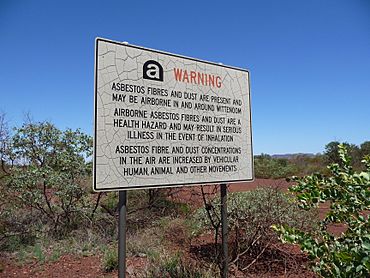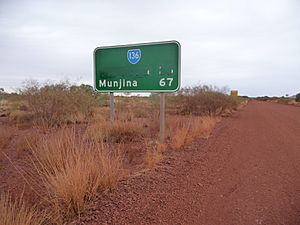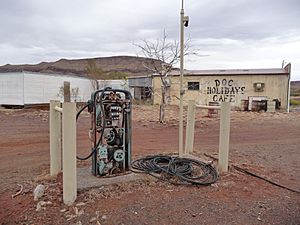Wittenoom, Western Australia facts for kids
Quick facts for kids WittenoomWestern Australia |
|||||||||
|---|---|---|---|---|---|---|---|---|---|

State government warning sign near the entrance to the former Wittenoom township.
|
|||||||||
| Lua error in Module:Location_map at line 416: Malformed coordinates value. | |||||||||
| Established | 1950 | ||||||||
| Gazetted | Degazetted June 2007 | ||||||||
| Postcode(s) | 6751 | ||||||||
| Area | [convert: needs a number] | ||||||||
| Location | 140 km (87 mi) from Tom Price | ||||||||
| LGA(s) | Shire of Ashburton | ||||||||
| State electorate(s) | North West Central | ||||||||
| Federal Division(s) | Durack | ||||||||
|
|||||||||
Wittenoom is a former town in Western Australia. It is also a declared contaminated site. This means the area is very dangerous due to harmful materials. It is located about 1,420 kilometers (882 miles) north-north-east of Perth. You can find it in the Hamersley Range in the Pilbara region. The contaminated area is huge, covering 50,000 hectares (123,553 acres). This makes it the largest contaminated site in the southern hemisphere.
The land around Wittenoom was mostly used for farming until the 1930s. Then, people started mining for a dangerous material called blue asbestos. By 1939, a lot of mining began in Yampire Gorge. This mine closed in 1943 when new mining started in Wittenoom Gorge. In 1947, a special town was built for the mining company's workers. During the 1950s, Wittenoom became the biggest town in the Pilbara region. At its busiest, on June 30, 1961, 881 people lived there. In the 1950s and early 1960s, Wittenoom was Australia's only source of blue asbestos. The mine closed in 1966 because it was not making enough money. Also, there were growing worries about people getting sick from the asbestos mining.
The Wittenoom Gorge Airport was used to bring workers and supplies to the asbestos mine. It later closed because its runways were made of gravel mixed with asbestos waste. This was a health risk.
The former town no longer gets government services like water or electricity. In December 2006, the Government of Western Australia announced that Wittenoom would no longer be an official town. In June 2007, Jon Ford, a government minister, said the town's official status was removed. The town's name was taken off maps and road signs. The local council, the Shire of Ashburton, can now close roads that lead to dangerous areas.
A special committee met in April 2013 to plan the town's final closure. They wanted to limit access to the area and warn people about the dangers. This plan included moving the last residents out. It also meant changing private land to government land and tearing down houses. Roads leading to the town would also be closed or changed. By 2015, only six people still lived there. This number dropped to four in 2017, three in 2018, and two in 2021.
As of September 2022, no one lived in Wittenoom anymore. The Western Australian Government started tearing down the remaining buildings in May 2023.
Contents
What is the History of Wittenoom's Name?
Wittenoom was named by Lang Hancock. He named it after Frank Wittenoom, who was his business partner at a nearby farm called Mulga Downs Station. Frank Wittenoom's brother, Sir Edward Horne Wittenoom, was a politician. He was the first to settle the land around Wittenoom.
By the late 1940s, people wanted the government to create an official town near the mine. The Mines Department suggested naming it Wittenoom. They said that local people really wanted this name.
The name was approved in 1948. However, the town was not officially recognized until May 2, 1950. In 1951, the mining company asked for the name to be changed to Wittenoom Gorge. But in 1974, it was changed back to Wittenoom.
The mine closed in 1966. The official removal of the town's status happened in March 2007.
What Was Religion Like in Wittenoom?
In 1968, Wittenoom was one of only two Catholic church areas in the entire Pilbara region.
How Did Wittenoom Start?
The Panyjima people, also known as the Banjima, originally lived in this area. They are an Aboriginal Australian group from the Pilbara region. They have special rights to the land.
In 1917, the Mines Department first found blue asbestos in the Hamersley Ranges. In the early 1930s, Lang Hancock discovered Wittenoom Gorge. This was on the Mulga Downs property.
In 1937, Hancock showed samples of blue asbestos (called crocidolite) to Islwyn Walters and Walter Leonard. These men were already mining white asbestos nearby. When Hancock learned the asbestos was worth a lot of money, he quickly claimed the best mining spots in Wittenoom Gorge.
Leo Snell, who hunted kangaroos on Mulga Downs, also claimed a spot in Yampire Gorge. This area had even more blue asbestos. Walters and Leonard bought Yampire Gorge from Snell. They moved their processing plant there and started mining. When Leonard told London that there were two miles of asbestos in Yampire Gorge, they thought he was joking. He had to send a photograph to prove it.
Walters and Leonard cleared a path into Yampire Gorge. They blasted large rocks and used camels to move them. Even after this, it took them seven hours to drive their truck 15 miles from the mine to their plant.
By 1940, 22 men worked at Yampire Gorge. About 375 tons of asbestos were mined and transported by mule wagons to the coast. During World War II, it became hard to communicate with England. A person named de Berrales then gained some ownership in the mines.
In 1943, the Colonial Sugar Company, through its company Australian Blue Asbestos Ltd., took over both the Wittenoom and Yampire Mines. Lang Hancock, who saw his farm turn into a town, said in 1958 that Izzy Walters made Wittenoom possible. Walter's partner, Len Leonard, also said in 1958 that Wittenoom would not exist without Walters' hard work.
However, the mine at Wittenoom was not making enough money. So, it closed in 1966.
As of 2024, more than 2,000 people who worked or lived in Wittenoom have died from diseases caused by asbestos. About 20,000 people worked or lived there in total.
Why Was the Town Closed?
As of 2016, only three people still lived in Wittenoom. They did not leave even though the Government of Western Australia planned to remove services. This included turning off electricity and buying the remaining private properties. The government also planned to tear down the town. There were still three residents in late 2018. In September 2022, the very last resident was asked to leave.
In November 2006, a report looked at the dangers of asbestos in the town. It said the risk to visitors was medium and to residents was extreme. In December 2006, Jon Ford, a government minister, said Wittenoom would no longer be a town. In June 2007, he announced that its official town status was removed.
Health experts and a contaminated sites auditor reviewed the report. They found that asbestos fibers on the ground were a serious public health risk. The auditor suggested that the former town and other affected areas should be called "Contaminated - Remediation Required." On January 28, 2008, the Department of Environment and Conservation officially called Wittenoom a contaminated site.
However, not everyone agreed about the danger. Mark Nevill, a geologist and former politician, said in 2004 that asbestos levels in the town were very low. He believed the real danger was in the gorge itself, where the mine waste was located.
Residents once ran a camping ground, a guest house, and a gem shop for tourists. Now, the roof of the gem shop has fallen in. The guest house wood is rotten, and the camping ground is gone.
In 2018, it was reported that thousands of travelers still visited the ghost town each year. They did this as a form of extreme tourism, visiting dangerous places.
The Australian Mesothelioma Registry (AMR) is a national database. It tracks information about people diagnosed with mesothelioma, a cancer caused by asbestos. This registry helps the government create plans to deal with asbestos. It also aims to reduce future cases of mesothelioma.
The Wittenoom Closure Bill was brought back to the Western Australian Parliament in August 2021. It was passed on March 24, 2022. This law allowed the government to buy the 14 remaining private properties. It also allowed them to tear down buildings in the former town.
The Panyjima people are the traditional owners of the land where Wittenoom is. They have asked the Western Australian Parliament to remove all buildings. They also want the land cleaned up so it is no longer contaminated.
The Wittenoom Closure Bill was passed in March 2022. This allowed the government to permanently close Wittenoom. They could buy the remaining private properties and remove all buildings. In September 2022, the last resident was asked to leave. As of September 2022, the town was empty and closed to the public. A bushfire reportedly hit the area around December 26, 2022. It damaged some remaining buildings. This also changed plans to demolish the site in 2023.
What is Wittenoom's Legacy?
The 1990 Midnight Oil song, "Blue Sky Mine", and their album, Blue Sky Mining, were inspired by Wittenoom. They were about the town and its mining industry. Songs like He Fades Away and Blue Murder by Alistair Hulett were also inspired by it. The town and its history are also part of the novel Dirt Music by Tim Winton.
Digital poet Jason Nelson created a work called Wittenoom: speculative shell and the cancerous breeze. It is an interactive piece that explores the town's end. It won the Newcastle Poetry Prize in 2009.
In the thriller novel The Dead Heart by Douglas Kennedy, there is a made-up place called Wollanup. This place is based on Wittenoom. The Dead Heart was also made into a comic book by Kennedy and artist Christian de Metter.
See also
 In Spanish: Wittenoom para niños
In Spanish: Wittenoom para niños



